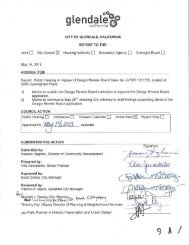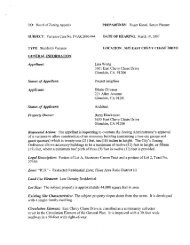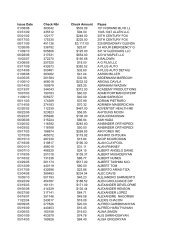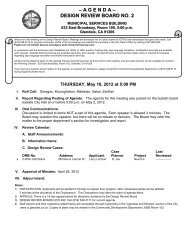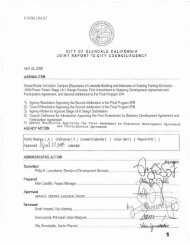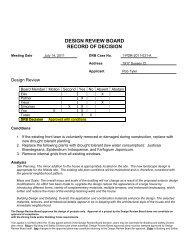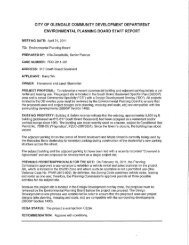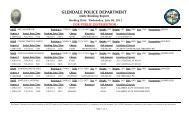&1J4~ - City of Glendale
&1J4~ - City of Glendale
&1J4~ - City of Glendale
You also want an ePaper? Increase the reach of your titles
YUMPU automatically turns print PDFs into web optimized ePapers that Google loves.
(<br />
.. :--<br />
,.<br />
<strong>City</strong> <strong>of</strong> <strong>Glendale</strong><br />
the G&S database. Step by step, queries are fonnulated using the visual data and the chosen<br />
statistics. You can refine a query by telling the computer to search specific attributes and by<br />
applying any conditions or restrictions needed. Once finished formulating the query, you send it to<br />
the database for results. In addition to sorting tile data in a variety <strong>of</strong> ways, i.e. alphabetically, by<br />
date, or by region, you can display the data using pie charts, bar graphs, or tables. You can also<br />
export information from the reports to spread sheets and word processors. GQL gives you full<br />
access to the DDS System databases, placing aU information needed to generate customized<br />
reports. The reports in the DDS System process four basic tables: trip, customer, vehicle and driver.<br />
The trip report lists all completed trips for a specified customer in a specified time period. The<br />
customer report gives you a complete list <strong>of</strong> all customers, and includes company names,<br />
telephone numbers and principle contact names. The vehicle report lists specifics on the vehicles in<br />
the fleet, in cluding vehicle's make, year, plate number and insurance status. The driver report<br />
catalogs each driver's name, telephone number and identification number. In addition, the DDS<br />
System provides 65 standard reports that can be printed hourly, daily, weekly, or monthly. Some<br />
examples are: Service Response Time, Reservationist Performance, Driver Activity, Vehicle<br />
Utilization, Zone Activity and Account (client or group <strong>of</strong> clients) Activity .<br />
• Redundant Base Controller<br />
G&S utilizes Digital Dispatch's Redundant Base Radio Controller (RBC), the most dependable radio<br />
controller on the market. The RBC ensures uninterrupted operation. It is completely redundant and<br />
fault tolerant, meanil)g it detects faults automatically and corrects them immediately. The unit has<br />
two identical processing boards and two power supplies. In the event that the main board or supply<br />
fails, the back up will automatically take over. The RBC's remote access commands, combined Witll<br />
the unit's self-correcting mechanisms, reduce the number <strong>of</strong> trips to the base controller's site for<br />
maintenance. A technician can access the internal dial-up modem and adjust parameters, monitor<br />
radio channels, Of send commands to tune the radio modem using the remote access commands.<br />
The RBC also has the capability to track many types <strong>of</strong> statistics. For example, it records the total<br />
number <strong>of</strong> outbound and inbound messages, the number <strong>of</strong> message errors and the total number <strong>of</strong><br />
base radio resets. These statistics are accessible via the unit's 4 line by 40 character LCD, a dial-up<br />
modem, or a terminal connection. The unit is equipped with a 4800 or 9600 bits per second radio<br />
modem, and the radio channel bandwidth is 12.5, 20 or 20 kHz. Digital Dispatch's RBG is the only<br />
redundant base controller on the market.<br />
• Multisite Network Co ntroller<br />
The MNG acts as the interface between the RBC(s) and the host computer and keeps track <strong>of</strong> the<br />
optimal radio site for each mobile unit. The MNC sits between the host computer and the RBCs and<br />
encodes/decodes messages from the RBCs to the host and vice-versa. Digital Dispatch supplies<br />
the MNG in several configurations. The most basic setup is the single channel, single site<br />
environment. For improved radio coverage, the MNC also manages the radio communications in<br />
the following configurations: multiple channels on different frequencies, multiple sites on the same<br />
frequency, or a combination <strong>of</strong> multiple sites and multiple channels. The MNC supports frequency<br />
reuse to increase coverage in systems with small antennas. Frequency reuse also enables<br />
companies to use multisite configuratio{ls where extra radio frequencies are not available. In a<br />
multisite environment, the MNC determines which transmitter will send and receive information. To<br />
avoid destructive interference in ar.eas <strong>of</strong> overlapping coverage, the MNC adapts a transmitter<br />
steering scheme and keys the transmitter when needed. The MNC has many advantages besides<br />
the significant increase in radio coverage for the mobiles. In many cases, the same dispatch system<br />
will be able to support more mobiles due to the increased throughp!lt. In addition, the MNC has<br />
many diagnostics built in to reveal statistical information pertaining to the radio infrastructure. There<br />
" '~ are also online setup parameters, and the MNC will support mobile roaming and alternate routing.<br />
The MNC can communicate with up to four RBCs on either the same or different frequencies. The<br />
G&S Transit Managoment, Inc. Page 28



